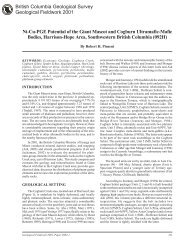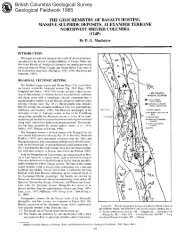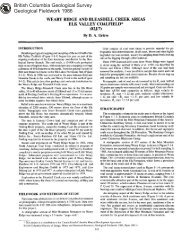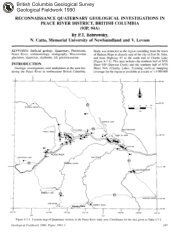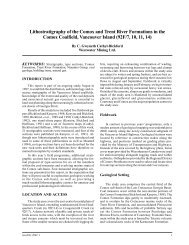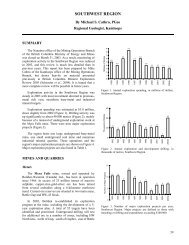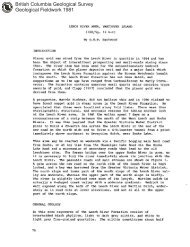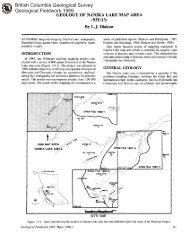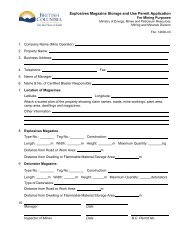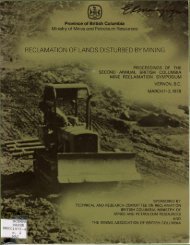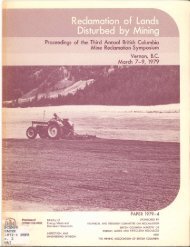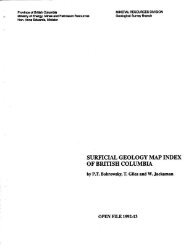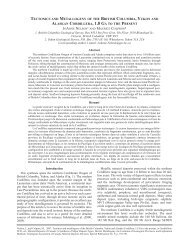disturbed by mining - Government of British Columbia Home page
disturbed by mining - Government of British Columbia Home page
disturbed by mining - Government of British Columbia Home page
You also want an ePaper? Increase the reach of your titles
YUMPU automatically turns print PDFs into web optimized ePapers that Google loves.
27The Interior Dry Belt <strong>of</strong> <strong>British</strong> <strong>Columbia</strong>'s Southwest Interior is characterized<strong>by</strong> the "rain shadow" effect which exists on the east side <strong>of</strong> the CoastRange Mountains. It is a region <strong>of</strong> limited precipitation, reduced cloudcover, abundant sunshine and frequent, strong, surface winds. Summers tendto be very hot and dry in the lower valleys with moderation at the higherelevations. Maximum summer temperatures in excess <strong>of</strong> 100° Fahrenheit arenot uncommon in the communities <strong>of</strong> Ashcr<strong>of</strong>t and Spences Bridge. Annualprecipitation in these communities varies between seven and ten inches.Natural vegetation along the Thompson River at these localities is sparse,consisting <strong>of</strong> sage brush, juniper, and small cactus, an assemblage typical<strong>of</strong> semi-desert conditions. Benchlands above the river are dotted withPonderosapine.Just a few miles to the east lies the Highland Valley which geographicallyoccurs within the Interior Plateau land form at elevations ranging from3,000 feet to 5,000 feet above sea level. This is a forested area <strong>of</strong> gentlyrolling hills with grassy meadows along the valley floor. Precipitation hereranges between 9 and 25 inches per year, most <strong>of</strong> which occurs during thewinter months in the form <strong>of</strong> snow. Summer temperatures here are moderatewith average maximum temperatures <strong>of</strong> 82° Fahrenheit. Winters tend to belong and occasionally very cold. Strong southwesterly winds are prevalentduring the months <strong>of</strong> April through June.The valley borders two biogeoclimatic zones; the Interior Douglas f i r zone <strong>of</strong>Douglas f i r , Ponderosa and Lodgepole pine; and the Engelmann spruce-subalpinef i r zone. Lower slopes <strong>of</strong> the drier north side <strong>of</strong> the valley are forestedwith Ponderosa pine and Douglas f i r . Lodgepole pine are also presentdepending upon the fire history <strong>of</strong> the area. Higher up the north side <strong>of</strong>the valley, the forests are predominantly Lodgepole pine with an Engelmannspruce component. Native plant species other than those which have alreadybeen mentioned include dwarf juniper, willow, trembling aspen, sedge,pinegrass, bluebunch wheatgrass, bluegrass, soapberry, wild rose, white



